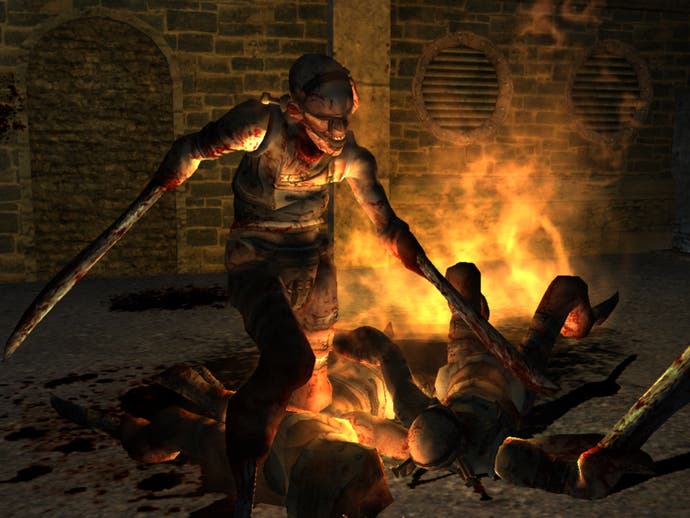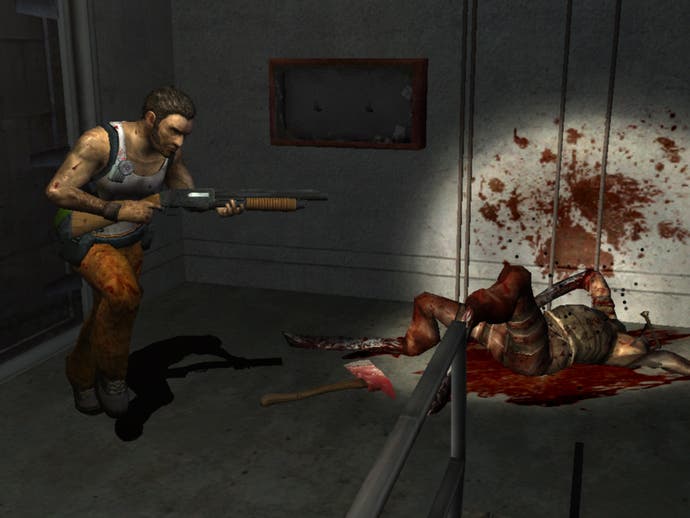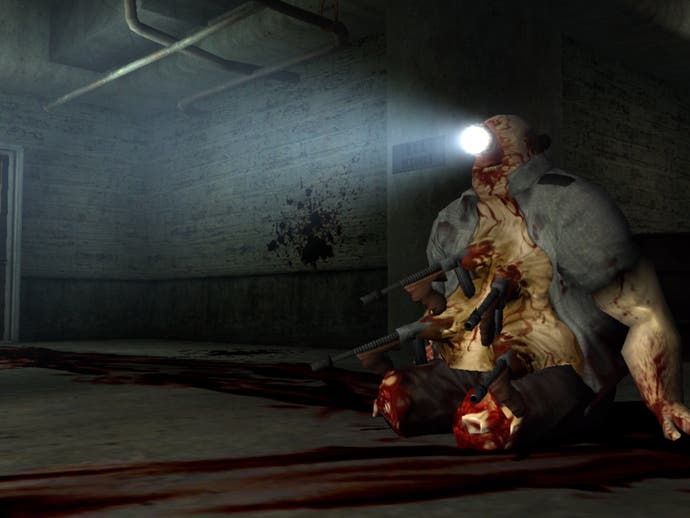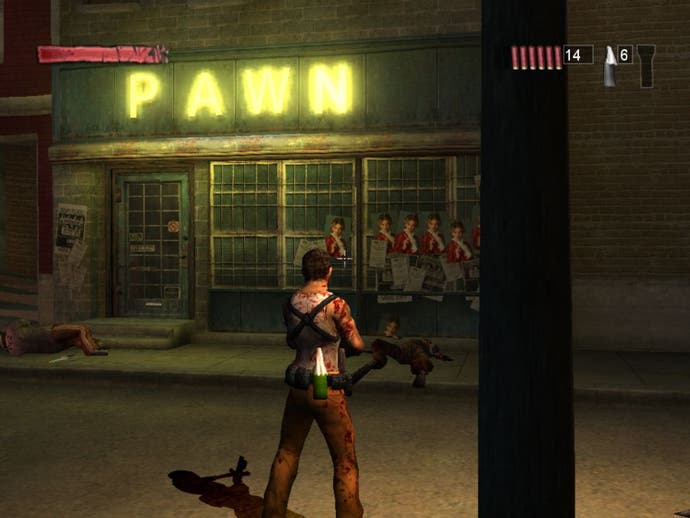The Suffering: Ties That Bind
Hands-on and interview with Surreal. (They touched us first.)
The Suffering's action-oriented take on the horror genre made for a refreshing change for fans with a thirst for the darker side of life when it arrived out of the blue last year. Carving itself a niche as an action-horror title certainly paid off for Midway, too, with the game going on to sell well over 500,000 copies worldwide, and managing to be one of a select few new brands to make any kind of impression on the masses at all.
In that context, it's hardly surprising that Midway commissioned Surreal Software to get to work on a quick-fire sequel, set for release barely a year after the original was released on PS2 and Xbox. Building on the strengths of the original and addressing some of the shortfalls, the game once again follows the adventures of former death-row convict Torque as he seeks revenge against the man responsible for the death of his family.
Set in the grim urban settings of Baltimore, Surreal is promising "new twisted creatures and a few familiar faces" in what is shaping up to be one of September's more action-packed titles. As before, the game is a mixture of all-out third-person gunplay and melee combat, but this time Surreal has given more weight to the latter element to give more variety to the gameplay as well as make use of all your capabilities.
Choice also figures more prominently in Ties That Bind, effectively giving the player the ability to direct the story in multiple directions that will result in distinctly different gameplay conclusions.
But not only has the game been designed to reflect player choice as you follow Torque's journey into madness, there are also multiple beginnings to the game as well. Ties That Bind picks up from where the previous game left off, reading your completed save game and choosing one of three beginnings to get proceedings underway. Quite how many possible paths there are through the game is hard to tell. More of it, we say.
Elsewhere, the game's disproportionate success on Xbox has encouraged Surreal to focus its efforts on making sure more attention to detail is lavished on this version, ensuring a smoother frame rate, better texturing and assorted graphical effects. So far our limited hands-on with the 20-minute demo version gave us the impression that it's been time well spent, with a much more assured look and feel than the promising - but not outstanding - original.
From our brief encounter, the game certainly promises a solid third-person action experience, which perhaps has more in common with the action served up in titles like Max Payne or The Punisher than the slower-paced thrills that fans of Silent Hill and Resident Evil are used to. And even though both these survival-horror franchises have upped the ante in the action stakes in recent incarnations, The Suffering's own brand of horror-action brings a very different prospect to the table. So while we await our final review code in the run up to the game's September 23rd release, we grabbed the game's Creative Director Richard Rouse for a chat to get us firmly in the mood for more psychological terror...

I'm the Studio Creative Director on Ties That Bind; I also wrote it. On the first game I was project lead/lead designer and writer. On the sequel I'm more creative director, which means I'm pretty hands on, particularly at the end here where we need to get everybody in there to get the game done, but definitely in terms of the writing. I did all the voice direction, and the recording of the story and stuff like that, coming up with what the different levels are going to be and all that stuff.
I was really happy with how we got a horror game that was not like the others. As much as I like Resident Evil or Silent Hill or something like that, this was something very different in that players were able to move the camera around wherever they wanted at any time - and this was all before Resident Evil 4 came out.
I was pretty happy; the story came out really well. Players seemed to really like it. That was something as we were working on the first game; people really got into the history stuff, and they got all the different layers of the story. Reading the forums people really picked up on that, and had all sorts of theories why different things were in there, so I think that worked out pretty well.
Out biggest focus this time around has been upping the visual presentation quality, making it look a lot cooler and tightening up the action mechanics and making it a more intense action experience.
On the technical side we've added a whole bunch of new effects. It's really the same engine by and large - we're coming to the end of the PS2 here - but we knew how to use it better this time. A lot of people see the game and say 'so, you did a new engine', and we're like 'well, it's the same engine but we changed how we built the game in terms of how the art was imported and how we used Maya to do things'. It's as if it's a new engine, but it's not actually.

Yeah. I mean for our next projects we're definitely looking at next-gen. I mean, we could do more with this generation, but it'd be cooler to do it on PS3 or 360 or whatever.
I think the way we reworked the insanity mode is really cool. That was something in the first game that was a pretty cool feature that not everyone used, just because it was more fun to play with the weapons. It was an action shooter and you got familiar with the shooting mechanics, and when you finally transformed into this creature you were like 'why do I need to use that? I like the guns'. So this time we've really worked on the balancing to make sure you're going to need to use it. We've really made the creature form a lot more fun to use in the first place. He's got more attacks; he's got a lot of attacks with a pretty big range. You're still a melee combat thing but you're really able to get out there more.
Also, the way it's tied into the morality system is really unique I think in that the creature has three different forms, and it changes depending on what moral path you're on. Not only does he look different, but he has different attacks as well, and each of the attacks are themed after different creatures in the game, so you've got one that's like the Triggerman, one that's like the Burrower, and another that's like the Isolationist whose our solitary confinement-themed character. Really, it's a lot more fun, and this time around you're really waiting for your meter to max out.
There are three stages on all sides.

As you play the game you make moral choices about the different human characters you encounter. You can save them and try to help them or you can ignore them or kill them. The blue stage creature is for the good path, though as I save more and more guys I get more and more attacks. The way you get them; the evil attacks you get quicker, but the good attacks are more powerful at the end. We wanted to balance it so it clearly felt different on the different moral paths.
It is possible.
That's certainly the hope.
I think if you go back far enough to the old Bard's Tale or Ultima games, when you finished those games you could port your characters into the new game and play as those people. That was sort of the inspiration at a very low level of like 'hey wouldn't it be cool if you could continue where you were?' So we’ve got that, and if you finish the game it unlocks the other beginnings, so, say if you didn't play The Suffering 1 three times to get the three different endings, you can play through this game, play with whichever beginning you start with, finish the game then you can go back and play again. As I said, the biggest impact is right at the beginning where you have three different scenes there.

The Shining is the one I always bring up as far as the psychological side of it. The action game stuff is closer to something like Half Life, that sort of level. I'm also a big fan of Ring and Dark Water.
The game plays the same, but the Xbox has higher resolution textures and a smoother frame rate, and little things like the flashlight look a little more jagged on the PS2. Apart from that it's basically the same.
I think the puzzles are a little more organic this time. Last time people came across puzzles and there were these mechanics that people had to learn for the first time, and we're a lot clearer about thing this time.
The play length is about the same, but the variety is definitely bigger. One thing I do know is that there were 1,700 lines of dialogue in the first game and there is 2,500 in this one.
The Suffering: Ties That Bind is due out on PS2 and Xbox from Midway on September 30th. Check back during the week of release for a full review.




.png?width=291&height=164&fit=crop&quality=80&format=jpg&auto=webp)



